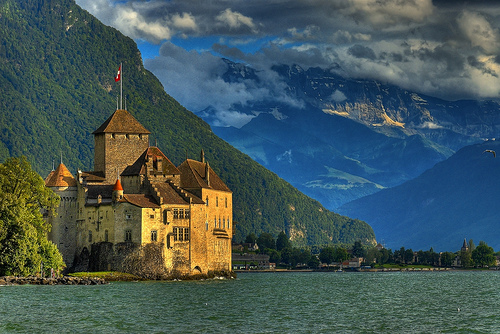

Location: 3 km from Montreux Map
Constructed: 11th century
Chillon Castle, known in French as Château de Chillon, is a medieval island fortress situated on the eastern shore of Lake Geneva (Lac Léman) in Veytaux, Switzerland, near Montreux in the canton of Vaud. Perched on a rocky outcrop that forms a natural island, the castle is surrounded by water on three sides, creating a dramatic and strategic setting that has made it one of Europe's most iconic and visited historic sites. Spanning over 1,000 years of history, it comprises 25 interconnected buildings, including towers, courtyards, dungeons, and halls, reflecting a blend of Romanesque, Gothic, and Renaissance architectural styles. Its significance lies not only in its military and residential roles but also in its cultural impact, inspiring literary works like Lord Byron's "The Prisoner of Chillon" and serving as a symbol of Swiss heritage. Today, it functions as a museum attracting over 400,000 visitors annually, offering insights into medieval life, Savoyard rule, and regional history.
The site's occupation dates back to the Bronze Age, with
archaeological evidence of prehistoric settlements, but the castle's
foundations trace to Roman times around the 4th century AD, when it
served as a fortified outpost guarding the road between Italy and
Burgundy. By the 12th century, under the House of Savoy, it evolved
into a major stronghold. The first written mention appears in 1150,
referring to a tower built by Count Humbert III of Savoy. During the
Savoyard period (12th-16th centuries), the castle expanded
significantly, serving as a residence for counts, a prison, and a
toll station controlling trade routes along the lake and through the
Alps. Key figures like Peter II of Savoy (the "Little Charlemagne")
in the 13th century fortified it further, adding defensive walls and
towers.
In 1536, during the Bernese conquest, Swiss forces from
Bern seized the castle after a brief siege, marking the end of
Savoyard control and the beginning of Protestant influence. It
remained under Bernese administration until 1798, when the Vaud
Revolution led to its transfer to the newly formed Canton of Vaud.
During this era, it functioned as a prison, most famously holding
François Bonivard from 1530 to 1536, whose captivity inspired
Byron's 1816 poem, boosting the castle's romantic allure and
tourism. In the 19th century, restoration efforts began, led by
figures like architect Eugène Viollet-le-Duc, transforming it into a
cultural monument. Excavations in the late 19th and 20th centuries
uncovered layers of history, confirming its multi-period
development.
Chillon Castle's strategic position on a narrow strip between Lake Geneva and the steep Alpine foothills made it a natural chokepoint for controlling trade and military movements. The "island" is actually a rocky promontory connected to the shore by a bridge, with a moat dug between the rock and mainland for added defense. Surrounded by the lake's deep waters (up to 310 meters nearby), it benefits from a temperate microclimate, with vineyards and mountains providing a scenic backdrop. The site's geology, featuring limestone and conglomerate rock, allowed for sturdy construction while offering natural fortifications. Proximity to Montreux (about 3 km) and easy access via train or boat enhances its tourism appeal in the Swiss Riviera region.
Chillon Castle's architecture is a patchwork of eras, with over 100
rooms across four courtyards, embodying defensive, residential, and
ceremonial functions. The oldest sections, like the 13th-century Gothic
dungeons (room 4), feature vaulted ceilings and pillars reminiscent of a
cathedral, carved directly into the bedrock and used as prisons and
storage. The keep, a massive square tower from the 12th century,
dominates the structure, flanked by conical-roofed turrets added in the
Savoyard expansions.
Key highlights include the Coat of Arms Hall
(room 18), with its 15th-century wooden ceiling commissioned by Duke
Amadeus VIII in 1436, adorned with Savoy emblems. The Domus Clericorum
(room 13), a 14th-century chapel, boasts frescoes depicting biblical
scenes and heraldic motifs. Defensive elements, such as machicolations,
arrow slits, and a drawbridge, underscore its fortress role. Renaissance
influences appear in later additions, like ornate fireplaces and
furniture in the banqueting halls. The castle's dense layout—25
buildings in a compact space—defies typical sprawling castle designs,
adapting ingeniously to the rocky site.
Chillon's cultural legacy is profound, particularly through its association with Bonivard's imprisonment, which Byron romanticized in his poem, drawing Romantic-era tourists and influencing artists like J.M.W. Turner and Gustave Courbet. It symbolizes the transition from medieval feudalism to Swiss confederation, reflecting power struggles between Savoy, Bern, and Vaud. As Switzerland's most visited historic building, it hosts exhibitions on medieval life, weaponry, and archaeology. Its role in trade control highlights economic history, with tolls funding Savoyard expansions. The castle also preserves artifacts like 14th-century murals and furniture, offering a window into courtly life.
Managed by the Château de Chillon Foundation since 1887, the castle is open year-round as a museum, with self-guided audio tours in multiple languages exploring its 46 points of interest. Restoration projects continue, focusing on preservation amid climate challenges like lake level fluctuations. It hosts events such as medieval festivals, concerts, and educational programs, drawing international visitors. In 2025, it remains a UNESCO-recognized cultural asset, emphasizing sustainable tourism in the Swiss Riviera.10 web pages